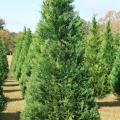Southern Gardening from 2013
You probably have figured out by now that I have a lot of favorite plants. Since it’s autumn, I get to talk about one of my favorite native plants that is in its full glory right now.
The American beautyberry is really putting on quite a show in Mississippi with clusters of bright purple berries.
American beautyberry is commonly found on the edges of woodlands all across the state. It is widely found east of the Mississippi in the mid-Atlantic and Gulf Coast region of North America.
As much as I’ve tried the last few weeks to encourage you to give summer annuals a chance to put on one last show, it’s time to start thinking about cool-season color. Probably the most recognizable cool-weather bedding plant is the pansy, a tough and reliable garden performer.
I really like the Cool Wave series of trailing pansies. If you think the name “Wave” sounds familiar, you’re right. Cool Wave pansies were bred by the same folks who brought the popular Wave petunias to many Mississippi gardens.
Gardeners don’t always think of native grasses as a landscape highlight, but fall is the time when one really puts on a show. Gulf muhly grass is at its best in the fall and winter months.
Gulf muhly grass has a unique texture with spiky, upright leaves that offer summer interest. But it’s the plant’s last grand flourish that creates true landscape excitement. Muhly grass flowers in billowy masses that resemble pink clouds in the landscape. As long as there isn’t a hard freeze, the color will hold. Even after a freeze, the flower heads keep their airy shape.
All gardeners know this is going to happen every year, and yet many are still surprised when it does. I’m talking about the arrival of freezing temperatures.
Despite the pleasant fall temperatures we are enjoying, there will come a time when we need to protect some of our landscape plants from freezing temperatures. And since no one reliably predicts the weather, now is a good time to get ready.
Many calls I receive are from gardeners who confuse frosts and freezes. While both are cold weather events, they are completely different.
Last year, I wrote about the wonderful citrus we can grow in Mississippi and how I was inspired by my friend Terry, who actually picked 1,800 Satsuma oranges from his two trees. You have to realize his trees are huge, and since they haven’t been pruned at all, he has to prop up the heavily laden branches with boards to keep them from snapping off.
What you are about to read is my experience as a first-time citrus grower.
It’s not too late to plant your winter color, but when you go to the garden center, resist the temptation to head straight for the pansies and violas. Consider putting some colorful ornamental kale and cabbage in your landscape this winter.
These ornamentals bring so many different colors and leaf textures to add landscape interest. Don’t plant a single type. Mix and match your favorites to create a display all your own.
Fall weather is always a treat because some of the plants that provide summer backgrounds step up and show off their stuff.
I’m not talking about flowers, although there are several plants that bloom in late fall and early winter. I’m talking about the landscape shrubs and small trees that put on dazzling displays of red berries. What can be more appropriate heading into the holiday season?
In their native Mexico, the bright red flowers of poinsettia are known as Flores de la Noche Buena – or Flowers of the Holy Night – as they bloom each year during the Christmas season.
If you’re a fan of poinsettias but like variety, you’ll find the range of poinsettia colors available is truly remarkable. Poinsettia is no longer simply “that red Christmas plant.” Colors range from red and white to even maroon for Bulldog fans, making it hard to choose. In addition to solid colors, there are bicolor, speckled and marbled poinsettias. There are even rose-flowered selections.
I hope everyone has Christmas traditions that their family looks forward to each year. One of the traditions I enjoyed growing up in the Great White North was going to get the Christmas tree.
Sometimes we went to one of tree lots that sprang up on corners like cold-weather weeds. Other times we drove out to the country and picked a tree to cut. It was like going hunting and bringing back the bounty. I grew up bringing home Fraser fir, balsam fir or Colorado blue spruce.
As much as I like decorating with colorful poinsettias during the Christmas season, I’m always on the lookout for nontraditional plants that can add interest and be just as effective in spreading holiday cheer.
One of the most unusual plants I’ve seen is miniature cherry tomato, in full fruit, displayed for holiday sales. While I didn’t run out and buy one of those, a plant I have admired for many years for the shady summer garden is Rex begonia.
Let me offer a suggestion if you have looked around your house this Christmas season and enjoyed the poinsettias but wished for a little variety. Next year, bring home some cyclamen to decorate your living area over the winter.
Cyclamen is a great indoor plant with a long blooming period that produces loads of colorful flowers.
Even though the weather in the middle of winter prevents much gardening with plants, dedicated and enthusiastic gardeners find ways to keep fun and interest in the yard all year long.
You may have seen garden art in other people’s yards, but have you considered bringing it into your own? A whimsical way to jump right in is to bring home a gnome.
Pages
- « first
- ‹ previous
- 1
- 2
- 3












